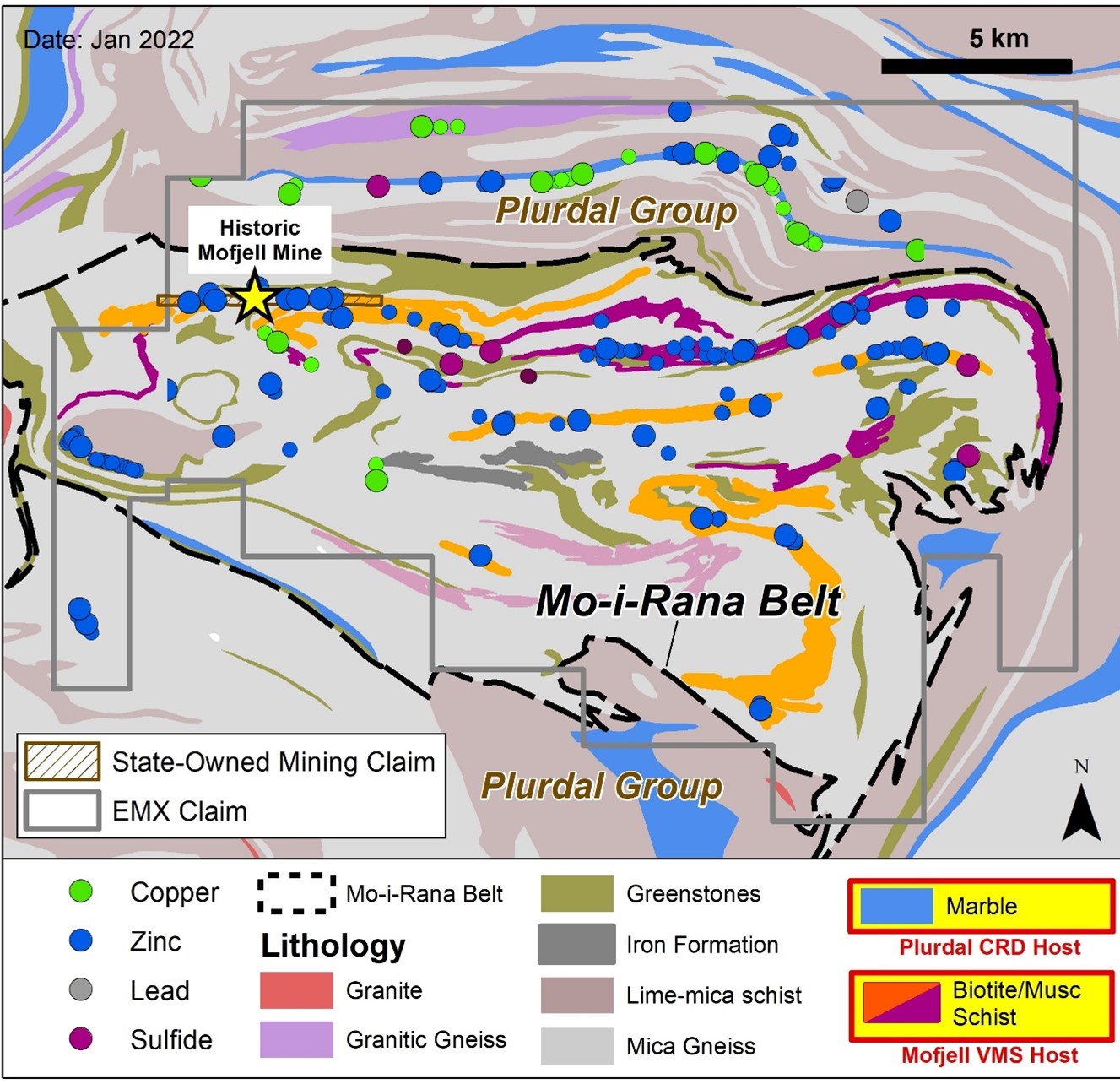Mo-i-Rana
The Mo-i-Rana project (the “Project”), located in central Norway was acquired by EMX in early 2021. The Project contains numerous polymetallic (zinc-lead-copper-silver-gold) occurrences and historical mines. The most notable deposit in the district is the Mofjell mine which produced 4.35 Mtonnes at 3.61% Zn, 0.71% Pb, and 0.31% Cu from 1928-19871. Over 200 mines and prospects with volcanogenic massive sulfide (“VMS”) styles of mineralization are located within the Mo-i-Rana project area, including ten former producing mines.
VMS and CRD style polymetallic deposits are developed in the Rana-Hemmes metallogenic region of Norway, which is also host to the prolific Rana Gruber iron mines as well as the nearby Bleikvassli Zn-Pb-Cu-Ag deposit, an EMX royalty property. This metallogenic area represents a tectonically displaced continuation of the Cambrian-Ordovician VMS belts in northeastern North America, which includes the Buchans and Bathurst VMS camps in eastern Canada, and also the Avoca VMS district in Ireland. As such, this represents one of the more prolific VMS belts in the world in terms of total production from its various mining districts, albeit now tectonically displaced and occurring along opposite sides of the Atlantic Ocean.
The Mofjell Mine deposit consists of three rod-shaped elongate VMS lenses, approximately 100 meters wide that extend for lengths of up to 2.8 kilometers. Just prior to mine closure, high gold and silver grades were discovered as disseminations in wall rocks within the historical mine workings (such as 2.8 meters averaging 3.88 g/t gold and 44.3 g/t silver in underground drill hole DD1313 and 3.7 meters averaging 2.30 g/t gold and 75.7 g/t silver in underground drill hole DD781A; true widths unknown2) but were never followed up3. This underscores the potential for additional discoveries of precious-metal enriched zones of mineralization in the belt.
Much of the historical exploration work was done at a time when VMS models were only poorly understood and only limited portions of the nine individual VMS horizons that exist in the belt have been tested to date. Additionally, most historical drilling was shallow (i.e., less than 100 meters) and clustered around the historical mine workings.
In 2008, a partnership between industry, the Norwegian Geological Survey (NGU) and the local county administration was formed to investigate additional potential in the Mo-i-Rana belt. This effort generated high resolution airborne geophysical data sets, as well as district scale mapping and geochemical sampling campaigns carried out by the NGU. These represent key data sets that EMX and Mahvie intend to utilize for further advancement of the Project.
On February 14, 2022 EMX executed an agreement to sell its Mo-i-Rana volcanogenic massive sulfide project in Norway to Mahvie Minerals AB (“Mahvie”), a private Swedish Company. In return for the transfer of the Project to Mahvie, the agreement provides EMX with a 9.9% equity interest in Mahvie, annual advance royalty payments, 2.5% Net Smelter Return (“NSR”) royalty interests, work commitments, and other considerations. EMX and Mahvie will apply modern exploration methods and deposit models to seek additional discoveries in the belt.
Comments on Sampling, Assaying and Adjacent Properties. Samples and geochemical assays mentioned in this news release are reported by Norwegian Geologic Survey. EMX has not performed sufficient work to verify the Project’s historical drill results or production data, but considers this information as reliable and relevant based upon the Company’s reviews of data from multiple independent sources. Additional drilling and sampling would be required to confirm these results.
The Mofjell Mine and other nearby mines and deposits provide context for EMX’s Project, which occurs in a similar geologic setting, but this is not necessarily indicative that the Company’s Project hosts similar mineralization.
EMX has not performed sufficient work to verify the projects’ historical resource estimate but considers this information as reliable and relevant.
1 Bjerkgård, et. al (2013). The Mofjell Project: Summary and conclusions. NGU (Norwegian Geological Survey) Report 2013.048.
2 Bergverkselskapet Nord-Norge A/S, 1987. As Reported by Directorate of Mining Norway. The historical drilling was completed by Bergverkselskapet Nord-Norge A/S, 1987 and archived by the NGU. EMX believes these results to be reliable and relevant
3 Berkgård, et al (2001). Ore Potential with emphasis on gold in the Mofjellet deposit, Rana, Nordland, Norway. NGU Report 2001.050.
Maps
Photos

 Click to Enlarge
Click to Enlarge